食物是一面镜子,从中可以折射一个人的性情和一种文化的风貌。
In some way, what you eat reflects who you are—as people and as a culture. So do you want to understand another culture? Find out about its food. Learning about American food can give you a real taste of American culture.
从某种程度上来说,你喜欢吃什么食物,能反映出你是什么样的人——人如此,文化也不例外。你想了解一种异域文化吗?那就从了解它的食物入手吧。了解美国人都吃些什么,能让你真正体味到美国的文化风情。
Coca-Cola
可口可乐
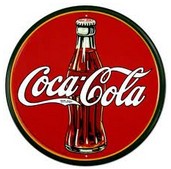 “We need a bottle which a person will recognize as a Coca-Cola bottle even when he feels it in the dark! The Coca-Cola bottle should be so shaped that, even if broken, a person could tell at a glance what it was.” This challenge, offered by the Coca-Cola Company in 1913, was met by the glassmakers at the Root Company in Terre Haute, Indiana. Inspired by the plump1) and rippled2) cocoa bean pod3), the Root team came up with the unmistakable silhouette4) in pale green glass that has meant “Coke” to generations of thirsty folks since 1916.
“We need a bottle which a person will recognize as a Coca-Cola bottle even when he feels it in the dark! The Coca-Cola bottle should be so shaped that, even if broken, a person could tell at a glance what it was.” This challenge, offered by the Coca-Cola Company in 1913, was met by the glassmakers at the Root Company in Terre Haute, Indiana. Inspired by the plump1) and rippled2) cocoa bean pod3), the Root team came up with the unmistakable silhouette4) in pale green glass that has meant “Coke” to generations of thirsty folks since 1916.
“我们需要这样的瓶子:即便是在黑暗中,你只要摸一下瓶子,就能知道那是可口可乐瓶!瓶子的形状要特别,即便瓶子碎了,你只要扫一眼碎片,就能看出来那是可口可乐瓶。”这是可口可乐公司在1913年提出来的一项艰巨挑战。鲁特公司(位于印第安纳州特雷霍特镇)的玻璃工人迎难而上,接受了这一挑战。公司的团队成员受到形状饱满、表面呈波纹状的可可豆荚的启发,设计出了一款独一无二、轮廓清晰的浅绿色玻璃瓶。对于1916年后的一代又一代饥渴大众而言,这一瓶子造型就是“可乐”的独特标志。
Oreos
奥利奥
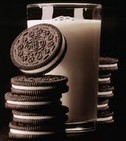 On March 6, 1912, New Jersey grocer S. C. Thuesen made history when he purchased a 9 1/4-pound tin of chocolate-sandwich cookies. Little did Thuesen know he was the first person ever to buy what would become the best-selling cookie ever: Oreos, which now sell at a rate of billions upon billions a year. It has been posited5) that if all the Oreos produced since Thuesen’s purchase could be stacked atop one another they would reach the moon four times.
On March 6, 1912, New Jersey grocer S. C. Thuesen made history when he purchased a 9 1/4-pound tin of chocolate-sandwich cookies. Little did Thuesen know he was the first person ever to buy what would become the best-selling cookie ever: Oreos, which now sell at a rate of billions upon billions a year. It has been posited5) that if all the Oreos produced since Thuesen’s purchase could be stacked atop one another they would reach the moon four times.
1912年3月6日,新泽西州的杂货商人图森买了一罐9.25磅的巧克力三明治曲奇饼,这一举动让他名垂史册。图森当时并不知道,他所购买的这款饼干将会成为最畅销的饼干品牌——奥利奥,而他正是购买这款饼干的第一位顾客。奥利奥饼干如今每年的销量达上百亿。曾有人假想过,如果把自图森开始购买奥利奥饼干后所生产的所有饼干层层叠加,其长度将是月球与地球之间距离的四倍。
Graham Crackers
全麦饼干
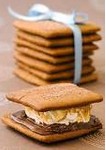 When Sylvester Graham, a frail and disgruntled6) early nineteenth-century Connecticut cleric, went searching for the root of all evil, he came up with a long list of possibilities. Topping the list was the American diet. Embracing his new calling as a nutritional moralist, Graham traveled the country inveighing7) against red meat, fats, alcohol, salt, sweets, condiments8), tobacco, and white bread. Graham alleged that these substances were not merely unhealthful, but downright immoral. Among their ill effects, he contended, were sexual excesses, family conflict, disease, and insanity.
When Sylvester Graham, a frail and disgruntled6) early nineteenth-century Connecticut cleric, went searching for the root of all evil, he came up with a long list of possibilities. Topping the list was the American diet. Embracing his new calling as a nutritional moralist, Graham traveled the country inveighing7) against red meat, fats, alcohol, salt, sweets, condiments8), tobacco, and white bread. Graham alleged that these substances were not merely unhealthful, but downright immoral. Among their ill effects, he contended, were sexual excesses, family conflict, disease, and insanity.
19世纪初期,康涅狄格州身体羸弱、牢骚满腹的教士西尔维斯特·格雷厄姆四处寻找万恶的源头,最后,他列出了一张长长的单子,上面是所有可能的答案。名列这张名单之首的,便是美国人的饮食。格雷厄姆积极担当起营养道德家这一新角色,在全国四处游历,大肆抨击红肉、肥肉、酒、食盐、糖果、调味品、烟草和白面包。格雷厄姆宣称,这些食物不仅是不健康的,而且是彻头彻尾不道德的。他指出,这些食物会带来不良影响,其中包括性放纵、家庭矛盾、疾病以及精神错乱等。
Graham’s recommendations were a mixture of asceticism9) and practicality. He advocated tooth brushing, frequent bathing, looser clothing, exercise, a vegetarian diet, clean air and pure drinking water, laughter as a digestive aid, and temperance10) in everything—all radical ideas in his day.
格雷厄姆的种种建议归纳起来,就是禁欲与务实。他提倡人们刷牙、勤洗澡、穿宽松衣服、做运动、吃素食、呼吸新鲜空气、饮用纯净水、多笑以助消化;主张人们对任何事情都要有个节制。在他那个年代,这些可都是激进的观点。
Fortunately, his zealotry11) contained several kernels12) of sound, albeit intuitive, advice. Graham’s Treatise13) on Bread and Bread-Making, written in 1837, made a persuasive case for what is now known as a high-fiber diet. And his assertion that whole-grain dark bread was preferable to bread made from refined white flour was later borne out14) by the twentieth-century discovery of vitamins15).
幸运的是,他的这些狂热言论尽管是出于直觉,却也包含一些合理的关键性建议。格雷厄姆在他1837年完成的《关于面包及面包制作的论述》一文中,提出了一种极具说服力的饮食方法,这一方法在今天被称为高纤维饮食。他还断言,全麦黑面包比用精白面制作的面包要好,这一论断在20世纪维他命被发现以后得以证实。
Even so, dissenters and even rioters16) often dogged17) Graham’s lecture tours. His reformist arguments attracted considerable ridicule and violent protests—especially from professional bakers and butchers.
即便如此,那些与格雷厄姆持不同意见的人和一些聚众闹事者还是经常跟踪他的巡回演讲。格雷厄姆的变革论调招致了人们的普遍嘲弄和强烈抗议——其中尤以专业的面包师和肉店老板为甚。
Graham’s bran18) crusade influenced many—including such prominent individuals as Horace Greeley19) and Ellen White20)—and sparked sweeping changes in America’s eating habits. In a time when many started the day with heaping platters of meat and potatoes, he ate a daily ration of dry, crumbled whole wheat biscuits: the original Graham crackers.
但是,格雷厄姆的“麦麸圣战”依然影响了很多人,包括像霍勒斯·格里利和埃伦·怀特这样的知名人士,同时也极大地改变了美国人的饮食习惯。当许多人把一盘盘堆得满满的肉和土豆塞进肚子,开始一天的生活时,格雷厄姆吃的却是每天定量的、又干又碎的全麦饼干——最初的格雷厄姆饼干。
Ironically, all-around health “expert” Graham never attained the vigor he promised others. He took his last righteous meal in the fall of 1851 and died at the early age of 57—but the cracker that bears his name lives on around the world.
颇具讽刺意味的是,全能的健康“专家”格雷厄姆却始终没有获得他向别人承诺的生命活力。1851年秋,他吃完了他无可挑剔的最后一餐后与世长辞,年仅57岁。然而,以他的名字命名的饼干却继续“存活”了下来,风靡全世界。
Cracker Jacks
好家伙玉米花
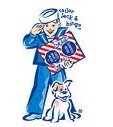 A prize in every box! That’s what generations of kids have looked forward to whenever they asked for Cracker Jack. But even before the popcorn, peanut, and molasses21) treat became identified with hidden treasure, it was one of America’s favorite snacks22). First finding popularity in 1871 when Frederick Rueckheim concocted23) the confection24) and sold it from his Chicago popcorn stand, it met with even wider acclaim when Rueckheim and his brother introduced it at the 1893 World’s Columbian Exposition. By 1899 Cracker Jack was distributed in snack-size boxes, and in 1908 it was immortalized in the song Take Me Out to the Ball Game25). When prizes were tucked into every package in 1912, Cracker Jack’s success was assured.
A prize in every box! That’s what generations of kids have looked forward to whenever they asked for Cracker Jack. But even before the popcorn, peanut, and molasses21) treat became identified with hidden treasure, it was one of America’s favorite snacks22). First finding popularity in 1871 when Frederick Rueckheim concocted23) the confection24) and sold it from his Chicago popcorn stand, it met with even wider acclaim when Rueckheim and his brother introduced it at the 1893 World’s Columbian Exposition. By 1899 Cracker Jack was distributed in snack-size boxes, and in 1908 it was immortalized in the song Take Me Out to the Ball Game25). When prizes were tucked into every package in 1912, Cracker Jack’s success was assured.
每个盒子里都有奖品!一代又一代的小孩在要好家伙玉米花时所期待的,正是这些奖品。其实,早在这款由爆米花、花生和糖蜜调和而成的美味与附送奖品有关联之前,它就已经是全美最受欢迎的零食之一了。1871年,弗雷德里克·洛克翰姆调制出这一甜食,并在他位于芝加哥的爆米花摊点上出售,其时它首次受到人们的追捧;1893年,洛克翰姆和他的弟弟将这一甜食带到了哥伦比亚世界博览会上,这为它赢得了更多的赞誉。到了1899年,好家伙玉米花开始以小包装的形式出售。1908年,好家伙玉米花出现在了歌曲《带我去看棒球赛》中,由此赢得了不朽的盛名。1912年,生产商在每一个包装盒里都装入了奖品,好家伙玉米花的成功便是势在必然了。
From the beginning, the prizes were remarkably inventive. Nestled in the mix were whistles, watches, watch fobs, and even Cracker Jack piggybanks that held five pennies—just enough to buy the next box. With prizes numbering in the thousands, a child could expect a new surprise with each new box.
从一开始,包装中附送的奖品就独具匠心。藏在这一甜食中的奖品有哨子、手表、表链,甚至还有好家伙玉米花储钱罐,里面还装有五便士——足够再去买一盒好家伙玉米花。奖品的数量有上千种,所以每个孩子在打开每一盒新的玉米花时都能期待获得一个新的惊喜。
Animal Crackers
动物饼干
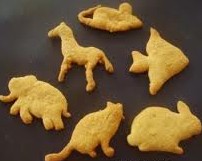 “If the kids can’t go to the circus, bring the circus to the kids” seems to have been the idea behind the introduction of animal crackers in 1902. Although animal-shaped cookies had been around for a long time, it was the National Biscuit Company that took them out of bins and tins and put them into compact, colorful boxes. The string handle on each box was originally meant for hanging on a Christmas tree, but the crackers gained year-round popularity and have taken the form of 37 animals over the years. Up to 18 different beasts may inhabit each box, including the ever-popular lions, tigers, and bears, as well as hyenas, camels, and seals.
“If the kids can’t go to the circus, bring the circus to the kids” seems to have been the idea behind the introduction of animal crackers in 1902. Although animal-shaped cookies had been around for a long time, it was the National Biscuit Company that took them out of bins and tins and put them into compact, colorful boxes. The string handle on each box was originally meant for hanging on a Christmas tree, but the crackers gained year-round popularity and have taken the form of 37 animals over the years. Up to 18 different beasts may inhabit each box, including the ever-popular lions, tigers, and bears, as well as hyenas, camels, and seals.
“如果孩子们没法去马戏团,那就把马戏团搬到孩子们面前。”动物饼干似乎就是秉承着这一理念于1902年问世的。尽管动物形状的饼干已经出现了很长时间,但却是美国饼干公司将这些饼干从大桶和大罐中“拿”出来,把它们紧实地装入彩盒中。动物饼干盒子上都系了一根小绳子,原本是为了方便将盒子挂在圣诞树上,但事实证明,动物饼干全年都很热销。这些年来,动物饼干已经有了37种动物的造型。每盒饼干中可能“栖息”着多达18种不同的动物,包括一直广受欢迎的狮子、老虎、熊以及土狼、骆驼和海豹。
Grape-Nuts
粒状麦粉
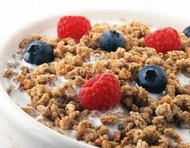 Charles W. Post, a traveling salesman and sometime venture capitalist, was among the many philosophical heirs of Sylvester Graham. Bedeviled26) by chronic digestive disorders and other health problems, Post tried a number of “cures” with little success. In 1884 he found his way to the Battle Creek27) Sanitarium28), a widely touted health spa directed by John Harvey Kellogg, MD.
Charles W. Post, a traveling salesman and sometime venture capitalist, was among the many philosophical heirs of Sylvester Graham. Bedeviled26) by chronic digestive disorders and other health problems, Post tried a number of “cures” with little success. In 1884 he found his way to the Battle Creek27) Sanitarium28), a widely touted health spa directed by John Harvey Kellogg, MD.
查尔斯·波斯特是一个旅行推销员,曾经做过风险投资,他是西尔维斯特·格雷厄姆饮食哲学的众多继承人之一。波斯特深受慢性消化系统紊乱和其他健康问题的困扰,他尝试过不少方法进行治疗,但都收效甚微。1884年,他费尽周折,来到了巴特尔克里克疗养院,这是一家由医学博士约翰·哈维·凯洛格管理的健康疗养院,声誉良好。
Patient Post endured a variety of treatments and some curious regimens29) at Kellogg’s “San”, including the Grahamite diet and instruction in the Chewing Song, a ditty Kellogg had composed to encourage thorough mastication30). But Post came away after nine months no stronger than when he had gone in. “Given up on by the doctors,” as he would later claim, he took his troubles to a Battle Creek Christian Science practitioner31). Within two days his appetite and strength returned.
在凯洛格的疗养院里, 病人波斯特经历了各种各样的治疗方法和一些奇特的养生疗法,包括“格拉厄姆式”饮食法和《咀嚼歌》(由凯洛格创作的一曲小调,鼓励人们细细咀嚼)指导疗法。但是,九个月后,波斯特拖着和来时一样虚弱的身躯离开了。波斯特后来说:“医生已经拿我没办法了。”带着自己的困扰,他向巴特尔克里克市基督教科学派里的一个信仰疗法术士寻求帮助。没过两天,他就食欲大振,体力也恢复如常。
Post was convinced he owed his recovery to a combination of natural foods and positive mental suggestion, and that there were untold marketing opportunities in such an approach. He opened his own spa and began experimenting with ways to prepare more palatable32) health foods. In 1895 he launched a bran, wheat, and molasses-based no-caffeine coffee substitute called Postum. Grape-Nuts, a gritty33) “scientific” formulation that had neither grapes nor nuts in its cereal34) mix, appeared in 1898. These were followed in 1906 by “Elijah35)’s Manna36)”, later rechristened37) Post Toasties.
波斯特深信,他能够重拾健康,有赖于“食用天然食物”与“积极心理暗示”的双重作用,他认为这一方法有着巨大的营销机遇。于是,他自己开了一家疗养院,并开始尝试用各种方法来制作更美味的健康食品。1895年,他推出了一款以麦麸、小麦及糖蜜为主要原料制成的无咖啡因咖啡替代品,将其命名为“波斯敦”。1898年,粒状麦粉诞生了,这一粒状的“科学”配方是一种谷物混合物,其中既没有葡萄,也没有坚果。继粒状麦粉之后接踵而来的是“以利亚的吗哪”,后来它又被更名为“波斯特烤面包。”
1. plump [plʌmp] adj. 鼓起的,丰满的
2. ripple [ˈrɪp(ə)l] v. 起波纹,呈波浪状
3. pod [pɒd] n. 豆荚
4. silhouette [ˌsɪluˈet] n. 轮廓
5. posit [ˈpɒzɪt] vt. 假定,断定
6. disgruntled [dɪsˈɡrʌnt(ə)ld] adj. 不满的,不高兴的
7. inveigh [ɪnˈveɪ] vi. 猛烈抨击,痛骂
8. condiment [ˈkɒndɪmənt] n. 调味品
9. asceticism [əˈsetɪsɪzəm] n. 禁欲主义,苦行生活
10. temperance [ˈtemp(ə)rəns] n. 节制
11. zealotry [ˈzelətri] n. 狂热行为
12. kernel [ˈkɜː(r)n(ə)l] n. (事物、问题的)核心,要点,精髓
13. treatise [ˈtriːtɪz] n. 论述,专题论文
14. bear out:证实……的话(或报道等)
15. vitamin [ˈvɪtəmɪn] n. 维他命。1897年,荷兰医生Christian Eijkman发现只吃精磨的白米可能会患脚气病,而未经碾磨的糙米能治疗这种病。1911年, 波兰生物化学家Kazimierz Funk鉴定出在糙米中能对抗脚气病的物质是胺类(amine),它是维持生命所必需的,所以建议命名为“vitamine”。后来又陆续发现许多“vitamine”,它们的化学性质不同,生理功能也不同,许多根本不含胺,但Funk的命名却继续沿用了下来,只是将最后的字母“e”去掉了。
16. rioter [ˈraɪət] n. 聚众闹事者,参加暴乱者
17. dog [dɒɡ] vt. 跟随,尾随
18. bran [bræn] n. 糠,麸
19. Horace Greeley:霍勒斯·格里利(1811~1872),美国著名报人、编辑,《纽约论坛报》的创办者
20. Ellen White:埃伦·怀特(1827~1915),一位多产的基督教作家,美国基督教先驱之一,基督复临安息日会(一个全球性的组织,拥有一千多万名信徒,遵守星期六为安息日,盼望耶稣快来)的精神领袖
21. molasses [məˈlæsɪz] n. <美> 糖蜜
22. snack [snæk] n. 小吃,点心
23. concoct [kənˈkɒkt] vt. 调制,调合
24. confection [kənˈfekʃ(ə)n] n. 糖果,甜点
25. Take Me Out to the Ball Game:《带我去看棒球赛》,美国歌手Jack Norworth写于1908年的一首歌,后成为非官方的棒球赛之歌。这首歌在第四句歌词中提到了“Cracker Jacks”,其前四句歌词如下:“Take me out to the ball game. Take me out to the crowd. Buy me some peanuts and Cracker Jacks. I don’t care if I never come back.”
26. bedevil [bɪˈdev(ə)l] vt. 使苦恼
27. Battle Creek:巴特尔克里克市,位于美国密歇根州中南部的工业城市,有“世界谷物之都”之称。
28. sanitarium [ˈsænət(ə)riəm] n. 疗养院
29. regimen [ˈredʒɪmən] n. 养生法
30. mastication [ˈmæstɪkeɪʃ(ə)n] n. 咀嚼
31. practitioner [prækˈtiʃənə] n. (基督教科学派的)信仰疗法术士
32. palatable [ˈpælətəb(ə)l] adj. 美味的
33. gritty [ˈɡrɪti] adj. 有砂砾的,砂砾般的
34. cereal [ˈsɪəriəl] adj. 谷物的
35. Elijah:以利亚,《圣经》中的重要先知,生活在公元前9世纪。
36. manna [ˈmænə] n. 吗哪(《圣经》故事中的一种天降食物),精神食粮
37. rechristen [riˈkrɪs(ə)n] vt. 重新命名
